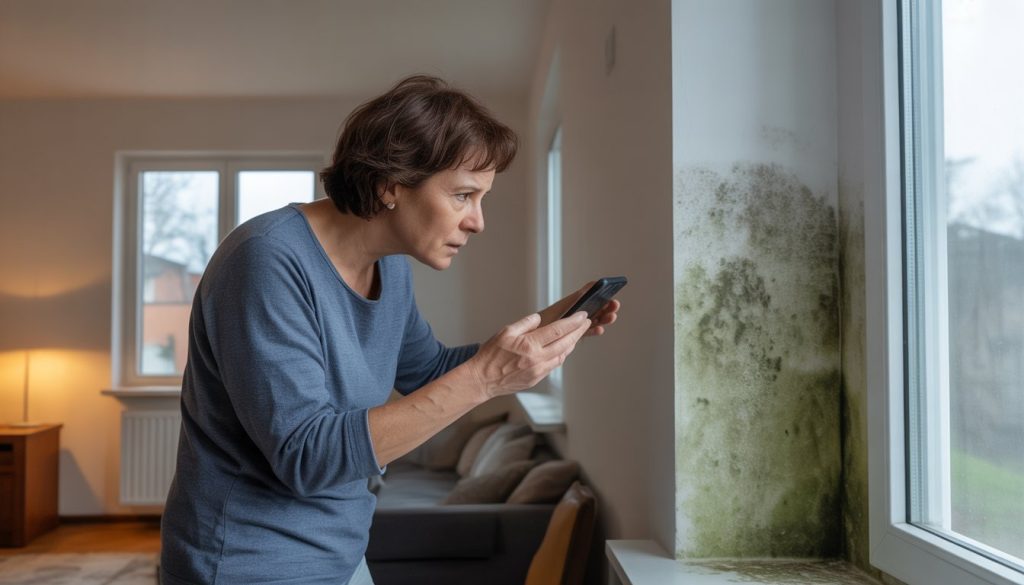Mold in Rentals: What Every Landlord Must Know

As a landlord, the health of your rental property doesn’t just impact your bottom line—it also affects the well-being of your tenants and your legal responsibilities. Mold can develop quickly in hidden spots, and if ignored, it can lead to costly repairs, health risks, and potential legal claims from tenants. Understanding your obligations and options for managing mold is essential for protecting your investment and staying compliant with relevant regulations.
Not all molds are immediately visible, and some strains can grow behind walls or under floors after a water leak or humidity issue. Landlords need to know the signs of mold, the health threats it poses, and what steps to take when mold is discovered. Addressing mold proactively isn’t just good practice; it may also be required under local laws.
Key Takeaways
- You need to recognize the risks and responsibilities tied to mold in rentals.
- Know how to spot and respond to mold to protect your property and tenants.
- Stay informed about best practices and FAQs for landlords regarding mold.
Understanding Mold in Rental Properties
Mold can compromise tenant health and property value if not addressed quickly. Recognizing the most frequent causes, potential risks, and key warning signs will help you manage your rental with confidence.
Common Causes of Mold in Rentals
Moisture accumulation is the leading cause of mold in rental properties. Leaks in plumbing, roofs, or windows often allow water to enter and remain trapped in walls or floors. Poor ventilation, especially in bathrooms and kitchens, further contributes to high humidity levels that foster mold growth.
You’ll see problems develop most rapidly in units with inadequate insulation, as condensation can form on cold surfaces. Flooding, even if minor or quickly cleaned, increases the likelihood of mold developing beneath floor coverings or behind drywall. Routine maintenance—including inspecting HVAC systems and sealing cracks—reduces moisture buildup and lowers the risk of mold formation.
Typical sources of moisture include:
- Broken pipes or fixtures
- Roof or foundation leaks
- Overflows from bathtubs or sinks
- Faulty or missing caulking around fixtures
Effective prevention depends on identifying and addressing these causes early before mold has a chance to spread.
Health Risks Associated With Mold Exposure
Mold exposure in your rental can trigger a range of health problems, especially in sensitive individuals. Common symptoms include coughing, sneezing, skin rashes, and eye irritation. Tenants with asthma or allergies may experience worse symptoms, such as difficulty breathing or chronic sinus congestion.
Exposure to specific types of mold, such as black mold (Stachybotrys chartarum), has been linked to more severe health effects. Prolonged exposure can even contribute to chronic fatigue, cognitive issues, and respiratory illnesses, which have led to serious legal actions by tenants in affected units. According to legal guidance, mold is considered an environmental hazard in rentals and can result in landlord liability for tenant illnesses if not resolved promptly. Read more about landlord responsibility for mold hazards.
You must respond quickly to any reports of mold in your unit. This makes your property safer while also reducing your legal and financial risk.
Signs of Mold in Rental Units
Detecting mold early in your rental is crucial for maintaining safe conditions. The most obvious indicator is a musty or earthy odor, which is especially noticeable near vents, windows, and areas prone to moisture. Visible discoloration—such as dark spots, patches, or stains—may appear on walls, ceilings, floors, or around window frames.
Other common signs include peeling paint, bubbling drywall, and persistent condensation on windows or cold surfaces. In spaces where mold grows unseen, like inside HVAC systems or behind appliances, pay attention to unexplained allergic reactions among tenants or reports of worsening indoor air quality.
A regular maintenance schedule and clear communication with tenants help uncover these issues faster. For more about identifying signs and steps to take if mold is suspected, see these tips for recognizing mold in rental property.
Tenant and Landlord Responsibilities for Mold

Mold issues in rentals often result from moisture or water problems, and both you and your tenants play important roles in prevention and response. Understanding specific obligations will help you protect your property and avoid disputes.
Tenant Obligations for Mold Prevention
Tenants must help maintain a healthy environment by minimizing moisture buildup in your property. Remind your tenants to use ventilation fans in bathrooms and kitchens, avoid drying clothes indoors, and address spills or minor leaks quickly.
A key role for tenants is to promptly report leaks, water damage, or ventilation issues. If they notice condensation or dampness in windows, walls, or ceilings, they should notify you right away. Unreported water problems are a primary cause of mold growth.
You can provide tenants with a checklist outlining simple preventive steps. For example:
- Open windows regularly for air circulation.
- Report plumbing or roof leaks immediately.
- Avoid blocking vents or airflow.
Written reminders and clear reporting procedures encourage timely communication and reduce the risk of major mold issues. Many states require that tenants maintain reasonable cleanliness, which includes managing moisture and informing you of problems, as noted by legal experts.
Landlord Duties for Mold Remediation
As a landlord, you are responsible for addressing mold issues stemming from building defects, leaks, or structural problems. Mold can worsen quickly, so act as soon as you receive a report from your tenant about water or mold.
Start with a thorough inspection to identify all affected areas. If the problem is minor, you may handle cleanup; larger outbreaks or hidden mold (inside walls) might require professional remediation. Document all findings and repairs.
You must fix leaks, seal moisture entry points, and dry water-damaged areas completely. If the mold results from a maintenance issue or damage not caused by the tenant, you will likely be responsible for repairs and removing the mold.
Install or repair ventilation systems, dehumidifiers, or exhaust fans where needed. Ongoing prevention measures, such as regular inspections and clear tenant instructions, support long-term mold control. Detailed guidance on your duties is available from experienced property managers.
Legal Rights Related to Mold in Rentals
Your legal obligations regarding mold vary by state, but you generally must provide a habitable living space. Many jurisdictions require you to address known mold or moisture problems within a reasonable period after notice from the tenant. Severe mold can lead to claims of uninhabitable conditions or breach of warranty of habitability.
Some states and cities have specific mold disclosure or remediation requirements during the rental process. Failing to comply can result in legal consequences, tenant lawsuits, or even forced relocation of tenants. Liability for damages can be significant if the mold causes health issues or extensive property loss.
To reduce legal risks:
- Respond promptly to tenant complaints about mold
- Maintain clear records of repairs and communications
- Stay updated on your state’s landlord-tenant laws
For more details on legal duties and potential liabilities, review landlord resources from Nolo and Lookmold.
Frequently Asked Questions
It is crucial for you to understand your legal obligations when mold is found in a rental. Proactive action and an awareness of tenant rights can help protect your property and minimize liability.
What are the tenant’s rights when dealing with mold in an apartment?
Tenants in California and many other states have the right to a habitable living environment, which includes being free from hazardous mold. If tenants discover mold, they can request repairs under the state housing code. You should familiarize yourself with relevant local laws and ensure compliance to avoid disputes and enforcement actions. More information can be found at the California Department of Public Health’s FAQ about mold in rentals.
What is the landlord’s responsibility in addressing mold issues in rental properties?
You are responsible for maintaining rentals so they remain habitable, which includes addressing mold promptly. This means inspecting complaints, removing the mold safely, and correcting underlying causes like leaks or poor ventilation. Failing to manage mold can expose landlords to potential health and legal claims. Comprehensive details are explained at Nolo’s page on landlord liability and prevention.
How long does a landlord legally have to respond to a mold complaint?
The time frame for response varies, but most states require landlords to address habitability complaints “promptly” or within a reasonable period, often interpreted as 30 days or less. Immediate action is recommended when health or safety is at risk. California law classifies mold as a substandard condition that should not be delayed.
Is it permissible for tenants to withhold rent if there is mold present?
In some jurisdictions, tenants may have the right to withhold rent until habitability issues, such as significant mold growth, are resolved. However, states have strict requirements, and landlords should address the problem quickly to avoid rent disputes or legal actions. Consult local statutes or seek legal advice to avoid adverse outcomes.
Under what circumstances can a tenant sue a landlord for mold-related issues?
Tenants may pursue legal action if you fail to remediate mold that makes the dwelling uninhabitable or causes health issues. Claims may include repair costs, medical expenses, or emotional distress damages. Some tenants have succeeded in substantial lawsuits when landlords did not act on repeated complaints or neglected obvious problems, as discussed in this overview on mold liability in rentals.
Are landlords required to provide relocation to tenants during mold remediation?
You may be required to provide temporary relocation if remediation makes the property temporarily uninhabitable, especially for significant mold issues caused by structural leaks or plumbing failures. Check your local and state laws for guidance on when and how relocation assistance should be provided, and document your decision-making process.
Would you like to publish a free blog post on this site?
Are you a real estate professional, property manager, or industry expert with valuable insights to share? We welcome guest contributors who can provide unique perspectives and actionable advice for our community of property investors and managers.
Guest posting is an excellent way to share your expertise while building backlinks and connecting with our engaged audience of real estate investors and professionals. Best of all, there’s no charge to publish your post on our site!

Master the art of real estate investing with The Real Estate Property Management Guide: Premium Edition – your comprehensive roadmap to successful property management.
Whether you’re a novice investor or seasoned professional, this guide covers everything from selecting the right investment properties to tenant management and property marketing.
The author, Jeff Rohde writing as Jeffrey Roark, is a professional with over 25 years of real estate experience. This Premium Edition includes the valuable bonus book Investment Real Estate Analysis: A Case Study to help you identify hidden opportunities and evaluate properties like a professional.
Learn practical, actionable strategies for both residential and commercial properties, from single-family homes to office buildings and shopping centers.
Don’t just buy property – learn how to manage it successfully and maximize your investment potential.
Grab your copy now from your favorite bookseller:
- Amazon (Basic Edition, does not include Investment Real Estate Analysis: A Case Study)
- Books2Read for Apple, Barnes & Noble, Kobo, Scribed, and 8 more sellers with both eBook and paperback options available ((Premium Edition, includes Investment Real Estate Analysis: A Case Study)
- Payhip as a downloadable PDF (Premium Edition)
Ready to take your business to the next level?
- Subscribe to our newsletter
- Visit the learning center
- Learn more about our consulting services